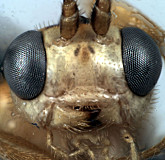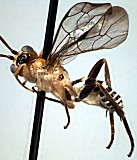Physotarsus oculatus Zhaurova, 2009
Physotarsus oculatus is similar to several other smooth-bodied species that have hyaline wings with an infumate apical spot, most notably P. eliethi Gauld, P. glabellus Zhaurova, P. jamesi Zhaurova, P. leucohypopygus Zhaurova, and P. niveus Zhaurova. As in P. leucohypopygus and P. niveus the hind femur on the outer or anterior face is entirely or almost entirely dark brown to black in P. oculatus but unlike the other two species, the ocellar field is dark brown in P. oculatus.
There are no specimens currently determined for this OTU, or those specimens determined for this OTU are not yet mappable.
This material is based upon work supported by the National Science Foundation under Grant Number DEB 0328922 with REU supplement DEB 0723663.
Any opinions, findings, and conclusions or recommendations expressed in this material are those of the author(s) and do not necessarily reflect the views of the National Science Foundation.



